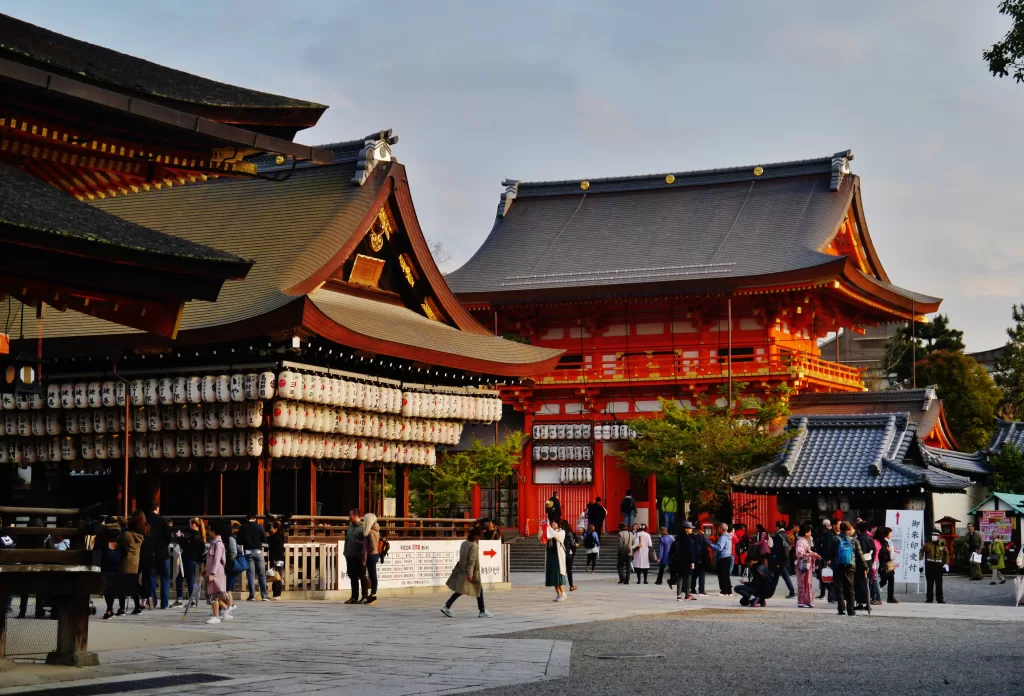Okera Mairi: A Unique New Year’s Tradition at Kyoto’s Yasaka Shrine

Fires and Fortune: The Symbolism behind Okera Mairi
The Yasaka-jinja Shrine in Kyoto, Japan, hosts a vibrant late-night festival known as Okera Mairi on New Year’s Eve annually. This unique cultural event features the symbolic burning of medicinal herbs believed to cleanse the negative energies from the previous year, ushering in new good fortune for the coming one.
As part of the Okera Mairi tradition, a medicinal herb is set ablaze during the festival. These iconic fires are believed to wipe away the evil energy of the year gone by. Devotees can take some embers home or light a candle with them to bring good luck into their life. To keep the flames alight throughout their journey home, attendees must continuously swing around a lit bamboo rope. It’s one of the most awaited Kyoto events in January.
One can also hang these ropes in their kitchen after extinguishing the flame, serving as amulets to protect from fires.
A Memorable Ritual: What Happens during Okera Mairi
During this captivating tradition, Okera tree roots are set ablaze in bonfires. Their flames are used to ignite two toro lanterns placed within Yasaka-jinja’s premises. Attendees crowd around these lanterns, lighting lengths of bamboo rope from them.
On reaching home, devotees use this sacred flame to light a candle for their household altar or kindle a fire over which zoni soup is prepared to greet New Year’s Day. Containing chicken, vegetables and mochi, zoni soup is considered one of the most auspicious dishes consumed on New Year’s Day across Japan.
The events commence at around 7 p.m. on December 31 and conclude at about 5 a.m. on January 1 when another ceremony starts. The Yasaka Shrine is just a short walk up Shijo Dori street from Gion-Shijo Station.

Yasaka Shrine: History and Cultural Significance
Much revered among locals who call it “Gion-san”, Yasaka Shrine serves as an important religious site for more than 2,300 shrines adhering to Gion faith across Japan. The shrine is dedicated to Susanoo no Mikoto- a god believed to erase all forms of misfortune- making it a fitting venue for the Okera Mairi celebration.
Known for its beauty and cultural heritage including Important Cultural Properties like the main shrine itself that’s recognized as National Treasure- Yasaka Shrine counts among Kyoto’s Higashiyama district’s most visited sights.
Apart from its natural beauty and historic value, this sacred place also houses a power spot called “Utsukushi-gozensha” that reportedly benefits beauty. Moreover, another deity named Kushinadahime or Kushinadahime no Mikoto (a god of love) is enshrined here along with Susanoo no Mikoto forming what locals believe as harmonious divine couple that beckons good fortune to those offering prayers here.
Schedule and Reason Behind Okera Mairi
Held late at night on each New Year’s Eve, the Okera Mairi or おけら詣り heralds new beginnings uniquely pertinent to Kyoto. The main event starts at 7:00 p.m., while observers may witness the okra fire-making ritual beginning from 4:00 a.m. on December 28th till three days later when priests move these fires from ‘okra fire’ lanterns stationed inside shrine’s primary structure into multiple ‘okra fire’ lanterns hanged within shrine’s boundaries following evening prayers.
Attractylodes or Rhizomes (also called ‘Okera’ in Japanese) get placed inside these lanterns and burnt off symbolizing warding off bad luck due to their pungent smell supposed to deter evil spirits while protecting people against illnesses and misfortune.
Visitors hereby light up lucky ropes known as ‘kitchounawa’ using flames emanating from these okra lanterns before swinging it round till they get it home safely where it gets displayed in kitchens signifying good health all year round after putting out their fire earlier.
The okra fires were traditionally lit outside shrines formerly acting as fuel essential for cooking typical New Year food items but then things changed resulting in praying using extinguished ropes instead supplementing curent lifestyle changes while welcoming upcoming year with renewed health expectations.
Other Celebrations at Yasaka Shrine
Alongside Okera Mairi ritual, several other significant events occur at Yataka Shrine including Hatsumode or first shrine visit of every new year wherein more than 1 million individuals visit here within first week every new year.
If you’re looking for a cultural and spiritual experience in Kyoto, don’t miss out on Hatsumode. Hatsumode is the Japanese tradition of visiting a shrine or temple to welcome the new year, and it’s a highly revered and popular event in Japan. Whether seeking blessings for the upcoming year, expressing gratitude for the past year, or simply immersing yourself in the festive atmosphere, Hatsumode in Kyoto is a journey through cultural ritual and tranquil serenity.